Note: This novel was WINNER of the (US) National Book Award in 2009, and WINNER in 2011 of the IMPAC Dublin Award, the literary world’s most valuable prize.
“At his center [Philippe Petit] never moved…He felt for the curve of the cable with the arch and then sole of his foot [as he began walking the tightrope strung between the Twin Towers of the World Trade Center, a quarter of a mile above the ground]. A second step and a third. Within seconds he was pureness moving, and he could do anything he liked. He was inside and outside his body at the same time, indulging in what it meant to belong to the air, no future, no past, and this gave him the offhand vaunt to his walk.” —August 1974.
Philippe Petit’s 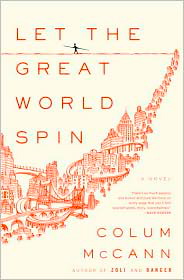 heart-stopping performance, as he walks the tightrope between the two World Trade Center towers, becomes the pivotal event of this magnificent (and monumental) “New York novel” in which Irish novelist Colum McCann examines many facets of the city’s life in 1974. Focusing first on the down-and-outers—prostitutes, the desperately poor, the drug- and alcohol-addicted homeless, the infirm elderly, gang members, casual thieves, and bright young people with no futures—he recreates the lower depths of New York, a place where its citizens every day walk the fine line between survival and death on a completely different tightrope from that of Philippe Petit. Like Petit, however, all of them also rejoice in moments of beauty, the only thing that can make their lives worth living—an unexpected kindness, the helpfulness of a friend (who happens to be a monk), and even the bright graffiti that shows up overnight, deep inside the tunnels of the subway. Unfortunately, for some, it also appears at the end of a needle.
heart-stopping performance, as he walks the tightrope between the two World Trade Center towers, becomes the pivotal event of this magnificent (and monumental) “New York novel” in which Irish novelist Colum McCann examines many facets of the city’s life in 1974. Focusing first on the down-and-outers—prostitutes, the desperately poor, the drug- and alcohol-addicted homeless, the infirm elderly, gang members, casual thieves, and bright young people with no futures—he recreates the lower depths of New York, a place where its citizens every day walk the fine line between survival and death on a completely different tightrope from that of Philippe Petit. Like Petit, however, all of them also rejoice in moments of beauty, the only thing that can make their lives worth living—an unexpected kindness, the helpfulness of a friend (who happens to be a monk), and even the bright graffiti that shows up overnight, deep inside the tunnels of the subway. Unfortunately, for some, it also appears at the end of a needle.
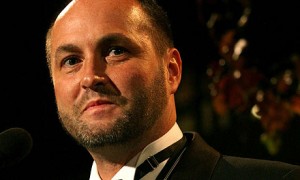
Misery is not limited by economic boundaries here, however, as McCann also shows through other characters, in other parts of the city. The emotional paralysis of Claire Soderberg, a Park Avenue matron, unable to resume her life after the death of her only child in Vietnam, is shared by her support group of four other mothers from all over the city, who have similar devastating losses. An artist from upstate New York, involved in a terrible accident in the city, is overwhelmed by her sense of guilt, and an educated Guatemalan immigrant, who had hoped to finish medical school in the U.S., must let go of her dreams.
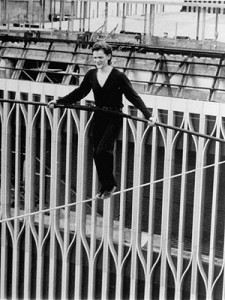
Petit walks between the Twin Towers
The novel begins with the arrival in the South Bronx of Ciaran Corrigan from Ireland, seeking his younger brother John Andrew, known simply as “Corrigan” or “Corry,” a monk who has studied in Belgium and who now lives a bare-bones life among addicts and prostitutes in the projects in the South Bronx. Often the brunt of their jokes and sometimes of fists, he provides a way-station for the prostitutes who need a place to stop between tricks. Two of them, Tillie and her daughter Jazzlyn, have good intentions and great street smarts, but they are unable to escape their surroundings, which offer a much-needed quick buck and help them to support Jazzlyn’s two little girls, and her dangerous drug habit.
Ciaran, afraid for the physical and emotional welfare of Corry, tries to persuade him to return home, but Corry, in the midst of a spiritual crisis, will not take the easy way out of the ministry he believes he was meant for, and Ciaran eventually decides that Corry is one of the world’s thirty-six “hidden saints…one who has lost his line with God: He bore the sorrows on his own.” Corry’s accident while driving Jazzlyn home from jail, adds two new characters to the novel, both of them artists in search of new inspiration and understanding of beauty.
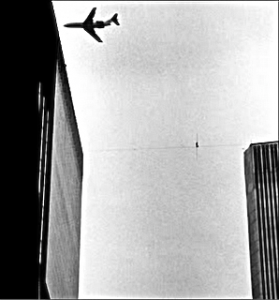
Iconic photo of Petit on wire as plane looks as if it’s crashing into the World Trade Center
Dense and impressionistic in style, McCann illuminates the lives of many well-developed characters living in various parts of New York City, always doubling back to images of Phillipe Petit on his tightrope, and always showing his characters’ overlaps, which supersede social class and neighborhood and eventually begin to resemble the “six degrees of separation.” Life in general is “nasty, brutish, and short” here, with no guarantees that it will ever improve, and as Tillie says of her life, “I don’t know who God is, but if I meet him anytime soon I’m going to get Him in the corner until He tells me the truth. I’m going to slap Him stupid.” As she sees it, “If you think of the world without people it’s about the most perfect thing there ever is. It’s all balanced and shit. But then come the people, and they fuck it up. It’s like you got Aretha Franklin in your bedroom and she’s just giving it her all, she’s singing just for you, she’s on fire, this is a special request for Tillie H., and then all of a sudden out pops Barry Manilow from behind the curtains.”
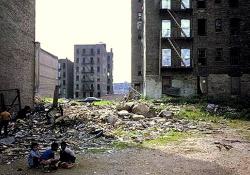
Image of the South Bronx
In the final section of the novel, McCann switches to 2006, as a character holds an inspirational photo of Phillipe Petit walking on his tightrope, with a low-flying plane above him that appears to be just a few feet from flying into the World Trade Center—“one small scrap of history meeting a larger one. As if the walking man were somehow anticipating what would come later…[But] the plane passes, the tightrope walker gets to the end of the wire. Things don’t fall apart…the man alone against scale, still capable of myth in the face of all other evidence.” In his gorgeous, lyrical descriptions of Philippe Petit’s walk, McCann suggests that this walk may be considered an extraordinary “gift” of beauty to the city below. And with this novel, McCann also makes such a gift, an extraordinary homage to New York, with all its flaws, its traumas, its heartbreak—and its beauty. (My Favorite Novel of 2009)
A video news report of Petit’s (real) tightrope walk appears below.
ALSO by Colum McCann: DANCER TRANSATLANTIC THIRTEEN WAYS OF LOOKING
Notes: The author’s photo is from the Guardian UK: http://static.guim.co.uk
The image of Phillipe Petit appears on http://www.miamiartzine.com
The motif of Petit’s walk while a plane goes overhead, appearing to be aiming for the World Trade Centers, appears as a still photograph on http://cube1986.blogspot.com
An image on this website by Sarah Nelson shows the South Bronx, where Ciaran Corrigan worked: http://www.aboutmyplanet.com
